"Witches on the Road Tonight" by Sheri Holman, Atlantic Monthly Press, 272 pages, $24
Some of the greatest moments in horror movies are when the monster shows a human side: Frankenstein's monster walks hand in hand with a little girl and smiles his first, shy smile. His bride recoils in shock when she sees the hideous creature she’ll marry. Who wants an ugly groom?
At these points, we recognize the “us” in “them” -- the times we’ve felt monstrous, misshapen, sensing that parts of us aren’t quite human or, at least, aren’t fit for public view.
In her fourth book, Sheri Holman (“The Dress Lodger,” “The Mammoth Cheese”) uses the language and imagery of horror movies to conjure up a spooky, multigenerational ghost story about the secrets that have haunted one family for more than 70 years.
For all its witchy moments, Holman’s book is sadly lacking in eye of newt or tongue of dog. Yet it concerns itself with something every bit as eerie and fascinating as the supernatural: the way we hide from ourselves.
The story opens as the retired host of a schlocky 1970s horror-movie show, “Captain Casket,” aka Eddie Alley, is about to lie down in the coffin he rose from on his show for 20 years. But this time he doesn’t plan on getting out again.
Elderly, demoralized by chemotherapy and unwilling to burden his partner with more caretaking, Eddie maps out his suicide in a brief soliloquy that includes a coded phone call to his daughter, Wallis, and a look back at the origins of his fascination with monster movies.
His story begins one October day in 1940 when two WPA workers, writer Tucker Hayes and his photographer girlfriend, are driving through rural Panther Gap, Va., and accidentally hit 8-year-old Eddie after he darts in front of their car. After taking the child home, Tucker sets up a projector and shows Eddie a film, the first he’s ever seen: Thomas Edison’s 1910 “Frankenstein.”
On that same afternoon, and for several days to come, Eddie’s mother, Cora, casts a strange spell over Hayes, who disappears not long after, never to be seen again, confirming something Eddie’s neighbors have suspected for years: that she can sour milk, conjure storms and ride a man to death if he isn’t careful.
“And they don’t even know what Eddie knows. The men she keeps buried in the woods. Or how she slips out of her skin from time to time, leaving it hanging on a peg in her bedroom, while she disappears through the keyhole.”
Or did Eddie just dream that up as a result of the ghost stories she tells him at night? It’s hard to tell, and Holman deliberately keeps us guessing as she offers scenes where the otherwise plain and downtrodden Cora slips her skin for steamy, sexually charged “rides” on the back of her reluctant male victim.
The rest of the novel continues this pattern of linked narratives, shuttling from 1940 to 1980 and the present day, revealing the stranglehold long-ago events still exert on Eddie and Wallis -- especially what happened the summer the Alley family took in a sullen, hostile teenage runaway named Jasper.
Through Wallis’ eyes, we see life as it was on the set of her father’s then-popular regional horror-movie shows -- the corny skits, the rubber bats, the smoking dry ice, the coffin she fell asleep in as a child. Through Eddie, we return to the austere beauty and brutality of his Depression-era childhood in chapters so vivid and lushly written they threaten to overpower the rest of the book.
Together, they flesh out the skeletons in the Alley family closet, telling the story of troubled marriages; lonely boys, father figures and the monster movies that connect them; and the unwieldy emotions girls and women feel toward boys and men who inspire equal amounts of love and loathing.
Shifting points of view and eras allow Holman to explore an ambitious collection of themes: the fearful “monsters” created by ignorance and prejudice; the burden of limited roles for women and how they can deform and disconnect; the myth of the obedient wife and mother and the tradition of heterosexual marriage; and the importance of a safety zone between fear and reassurance and whether in today’s world we can still expect to find it.
If from time to time her characters stagger under the weight of Holman’s messages -- Wallis, especially, entertains thoughts about sex and destiny out of reach of most 12-year-olds of that time -- this is a minor flaw in an otherwise believable story.
“Real witchcraft doesn’t follow a script,” Wallis realizes toward the end of “Witches on the Road Tonight.” Yet she wishes she had one, so she could put Jasper into a deep sleep, so “she could kiss him when she wanted and ... animate the parts that pleased her and keep napping the parts that didn’t.”
The best novels don’t follow a script either, and Holman offers no easy answers to the questions she asks in this one. It casts its spell, though, and -- like the Frankenstein movie seen in its first few pages -- reminds us of the dark side that's trapped in the mirror until we’re willing to look long enough to see what’s really staring back.
Author appearance
Sheri Holman, "Witches on the Road Tonight." 7:15 p.m. March 21. Talk and signing. Free. Decatur Library Auditorium, 215 Sycamore St., Decatur. 404-370-8450, Ext. 2225; www.georgiacenterforthebook.org.




